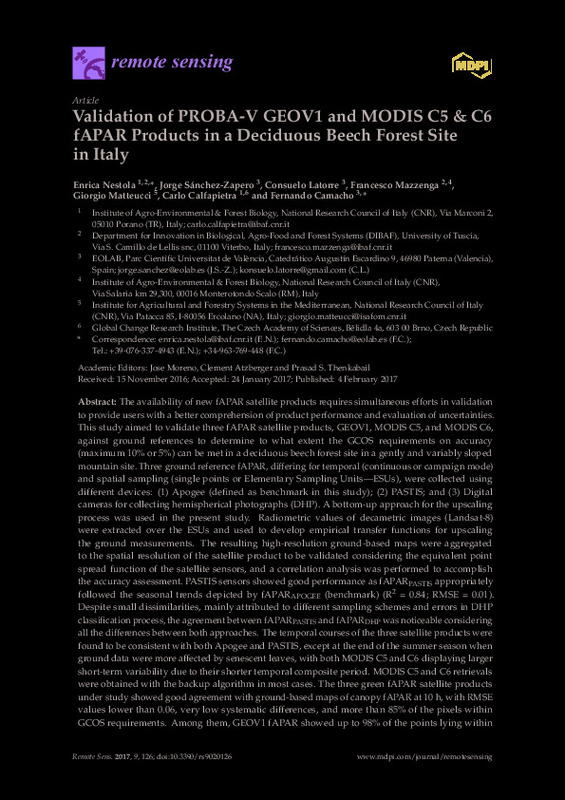JavaScript is disabled for your browser. Some features of this site may not work without it.
Buscar en RiuNet
Listar
Mi cuenta
Estadísticas
Ayuda RiuNet
Admin. UPV
Validation of PROBA-V GEOV1 and MODIS C5 & C6 fAPAR Products in a Deciduous Beech Forest Site in Italy
Mostrar el registro completo del ítem
Nestola, E.; Sánchez-Zapero, J.; Latorre-Sanchez, C.; Mazzenga, F.; Matteucci, G.; Calfapietra, C.; Camacho, F. (2017). Validation of PROBA-V GEOV1 and MODIS C5 & C6 fAPAR Products in a Deciduous Beech Forest Site in Italy. Remote Sensing. 9(2). https://doi.org/10.3390/rs9020126
Por favor, use este identificador para citar o enlazar este ítem: http://hdl.handle.net/10251/203310
Ficheros en el ítem
Metadatos del ítem
| Título: | Validation of PROBA-V GEOV1 and MODIS C5 & C6 fAPAR Products in a Deciduous Beech Forest Site in Italy | |
| Autor: | Nestola, Enrica Sánchez-Zapero, Jorge Latorre-Sanchez, Consuelo Mazzenga, Francesco Matteucci, Giorgio Calfapietra, Carlo Camacho, Fernando | |
| Fecha difusión: |
|
|
| Resumen: |
[EN] The availability of new fAPAR satellite products requires simultaneous efforts in validation to provide users with a better comprehension of product performance and evaluation of uncertainties.
This study aimed to ...[+]
|
|
| Palabras clave: |
|
|
| Derechos de uso: | Reconocimiento (by) | |
| Fuente: |
|
|
| DOI: |
|
|
| Editorial: |
|
|
| Versión del editor: | https://doi.org/10.3390/rs9020126 | |
| Código del Proyecto: |
|
|
| Agradecimientos: |
The ground data collection was partially funded by the FP7 ImagineS project (FP7-SPACE-2012-311766) and the dataset acquired is available online (http://www.fp7-imagines.eu/). We thank the project H2020 Ecopotential (grant ...[+]
|
|
| Tipo: |
|








